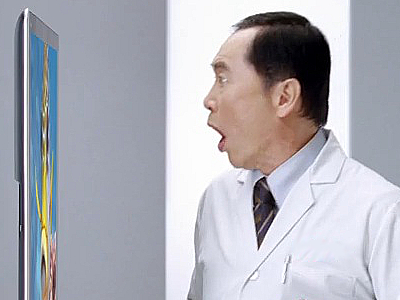Consumers Using Smart TVs for Watching, Not Facebook
Consumers are actually using Smart TVs to watch TV.

John Buffone, Director of Devices at the NPD Connected Intelligence group, said that consumers who purchase Smart TVs typically only use them to watch TV instead of connecting with friends on Facebook, tweeting the latest gossip on Twitter, surfing the internet and more.
According to Buffone, the Internet-connected TV has failed to break beyond "the bounds of its TV-centric heritage". Yet the connected TV has opened to doors to alternative sources of video content like Netflix, Hulu Plus and more premium services. In fact, six out of ten consumers who own an Internet-connected TV uses these Over-the-Top (OTT) video services directly on the device.
"The decision is not for want of application choice, but rather seems to be focused on how consumers are used to interacting with their TV," he said. "The one saving grace to-date has been music services, where the location of the TV and the availability of key music streaming apps such as Pandora has driven reasonable consumer uptake (roughly 15-percent)."
Even gaming consoles, Blu-ray Disc players, and other connected devices that offer an "array" of applications are failing to resonate with the Twitter and Facebook audience. That's because there are better platforms for socializing and web browsing including tablets, smartphones and laptops, he said.
Buffone pointed out that TV manufacturers are failing to bring the platform into the next stage of its evolution despite the Internet connectivity and apps. To make things worse, connected devices like the Xbox 360 are focusing on TV and video-centric apps – Microsoft's own console will receive more than 40 additional television apps in the near future – making it difficult for Smart TV OEMS to provide a unique product.
"The challenge may be that too much choice is creating a complex user experience," he said. "There are six or more types of devices bringing the Internet to HDTVs: the TV itself, video game consoles, Blu-ray Disc players, streaming media set top boxes, TiVo, and a few audio/video receivers. While 15-percent of HDTV displays are connected directly to the Internet, that number increases to 29-percent of HDTVs screens due to these other devices."
He points out that this multi-device setup is creating an average of two connected eco-systems on the same TV screen. This is leading to a "confused user-experience" because consumers have more than one way to access their favorite TV apps. As an example, a console gamer may have both the Xbox 360 and PlayStation 3, yet may rely on the PS3 to watch Netflix because the consumer doesn't want to pay an additional monthly fee to watch the same Netflix content on the Xbox 360 (aka Netflix + Xbox Live).
Sign up to get the BEST of Tom's Guide direct to your inbox.
Get instant access to breaking news, the hottest reviews, great deals and helpful tips.
"An added wrinkle comes from the nascent trend towards 'content throwing,' allowing programming to be transferred from the smartphone or tablet to the big screen," he said. "This is yet another challenge to the uniqueness of any one TV OEM’s device offering, especially as the throwing technology may also be driven by peripheral devices such as the Xbox."
To read the full report, head here.
Kevin started taking PCs apart in the 90s when Quake was on the way and his PC lacked the required components. Since then, he’s loved all things PC-related and cool gadgets ranging from the New Nintendo 3DS to Android tablets. He is currently a contributor at Digital Trends, writing about everything from computers to how-to content on Windows and Macs to reviews of the latest laptops from HP, Dell, Lenovo, and more.
-
sacre I rarely watch TV anymore. Sick of the commercials, I don't want to be forced to watch 2-3 minutes of crap to get back to my show.Reply
So thankfully I can watch movies on demand at a click of a button, same with TV shows, everything. Its a glorious thing. -
back_by_demand sacreI rarely watch TV anymore. Sick of the commercials, I don't want to be forced to watch 2-3 minutes of crap to get back to my show. So thankfully I can watch movies on demand at a click of a button, same with TV shows, everything. Its a glorious thing.42 minutes of TV showReply
18 minutes of commercials
every hour
thank god for torrented TV shows where some bright spark has de-commercialised every episode
by the way seeing as I pay for cable TV already you can stick your anti-piracy ourage up your ass -
Parsian Now I can only give up Blu Ray if they can match the quality for downloadable movies. I cant current downloadable/stream services.Reply -
Shin-san Not surprising. You usually use TVs for killing brain cells by not doing anything related to workingReply -
back_by_demand ParsianNow I can only give up Blu Ray if they can match the quality for downloadable movies. I cant current downloadable/stream services.Movies can get streamed in 1080p, you just need to let it buffer a bit before playing if your don't have really fast internet, or if you mean you can't download at all then get the internet, it's really cool and they have loads of videos of cute catsReply -
A Bad Day sacreI rarely watch TV anymore. Sick of the commercials, I don't want to be forced to watch 2-3 minutes of crap to get back to my show. So thankfully I can watch movies on demand at a click of a button, same with TV shows, everything. Its a glorious thing.Reply
I usually watch PBS because it's the only interesting channel that isn't loaded with 20 minutes of ads for 40 minutes of some content... -
DRosencraft Majority of people don't have the internet needed to stream video like that in high def. Suggesting they wait for it to buffer is a bit ridiculous because chances are you'll be wasting as much time sitting around staring at an un-moving picture as you would looking at commercials. You'd be surprised by how many people don't have internet, let alone internet of sufficient quality to stream media. My family lives on Florida's Gulf Coast. We have the highest speed internet service available in the area and if two people try to stream video at the same time, no one can use the internet at all, let alone actually watch the video because the stream slows down so much.Reply
In general there are so many alternate devices for Facebook or Twitter, anyone who seriously bought one of these TVs thinking they'd use it for that was fooling themselves to help justify buying something new and flashy they probably didn't need. Smart TVs are one of those things where they thought of combining like technology into one space, but did not offer any appreciable benefit through that unity. -
back_by_demand drosencraftMy family lives on Florida's Gulf Coast. We have the highest speed internet service available in the area and if two people try to stream video at the same time, no one can use the internet at all, let alone actually watch the video because the stream slows down so muchCool story broReply
So, large Amish community down there? -
mgolus back_by_demandMovies can get streamed in 1080p, you just need to let it buffer a bit before playing if your don't have really fast internet, or if you mean you can't download at all then get the internet, it's really cool and they have loads of videos of cute catsReply
The video may technically be the same resolution, but the high compression used on streaming video makes for a noticeably worse picture quality than Blu-Ray. Not to mention that even though some of the streaming services offer Dolby 5.1 surround (often at a lower bit-rate than on DVD), none currently offer Dolby TrueHD or DTS-HD. And yes, if you have a decent surround sound system, it is quite easy to tell the difference there as well.
Don't get me wrong, streaming is great. It's awesome to have a wealth of content at the click of a button. But, for any of my favorite movies, I much prefer to own and watch them on a Blu-Ray disc to enjoy the higher quality video and audio. -
NuclearShadow I own a nice Smart TV and I have to admit I never use it for anything that a normal TV has. I suppose if all the PCs, tablets, and even my fridge goes online and can sends tweets on twitter for so ungodly reason. If all those go maybe I'll actually use my smart TV as a smart TV.Reply
